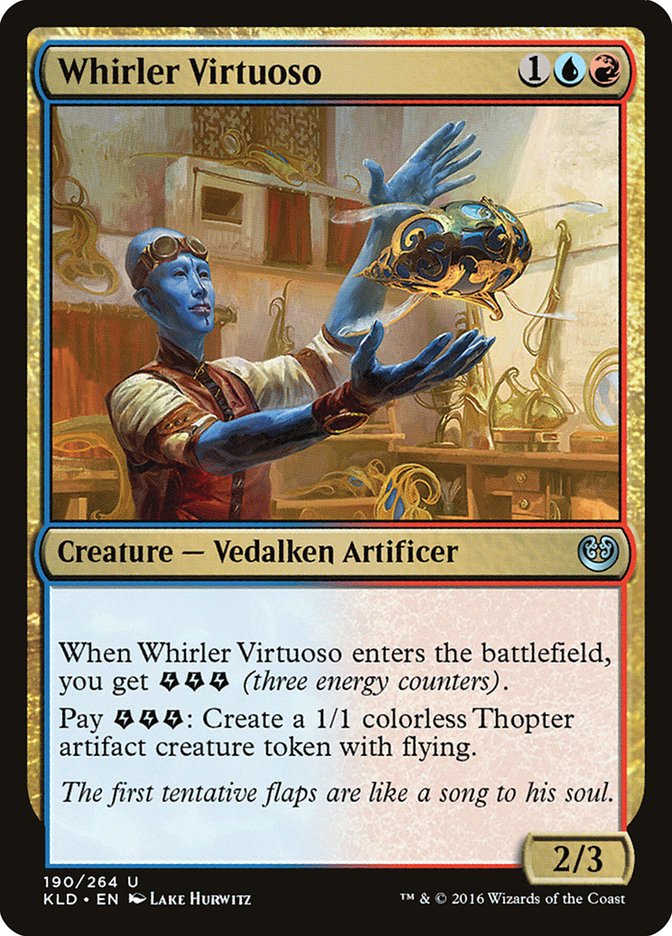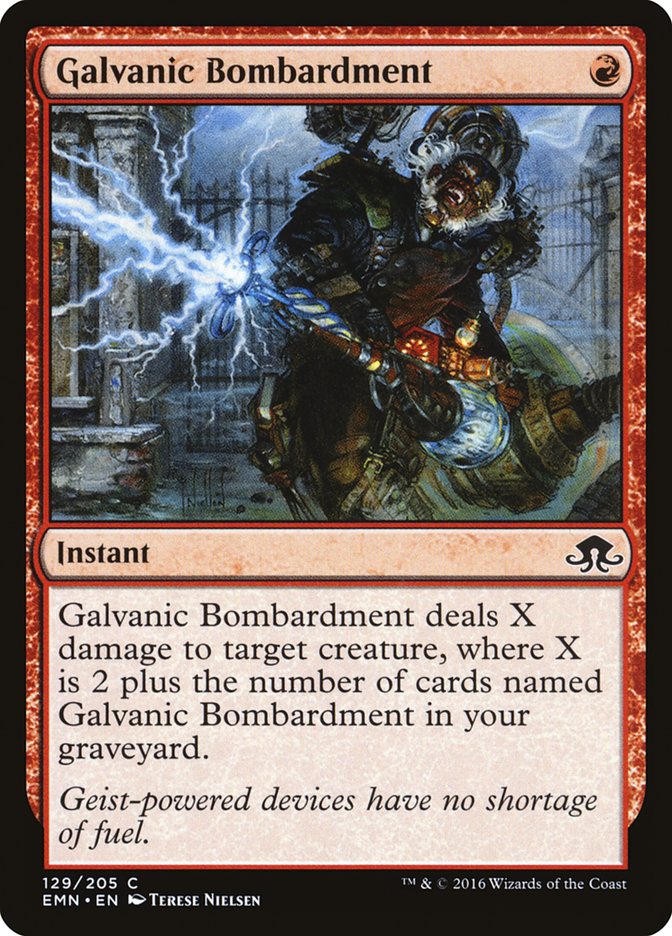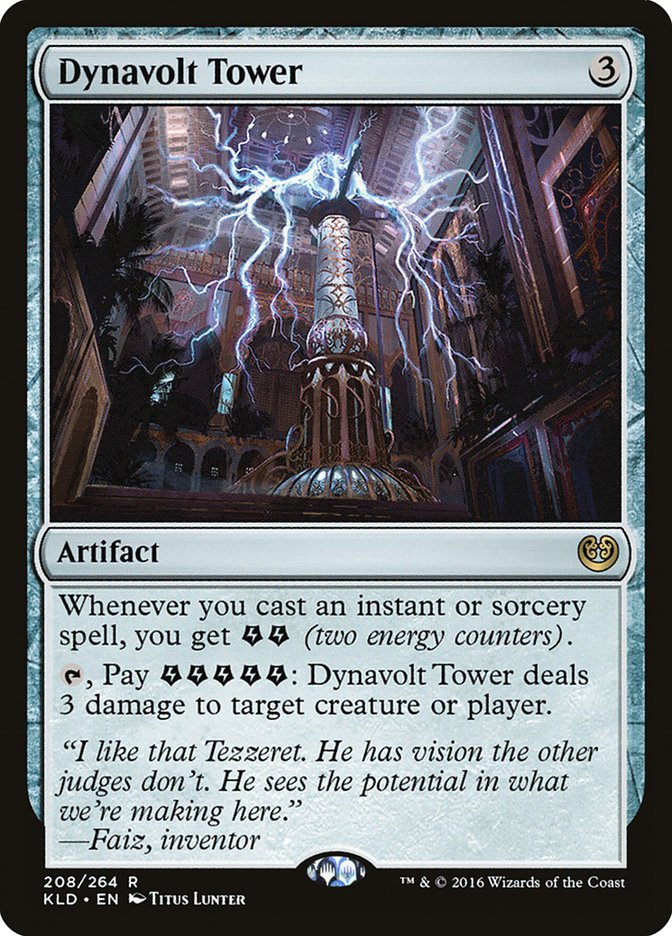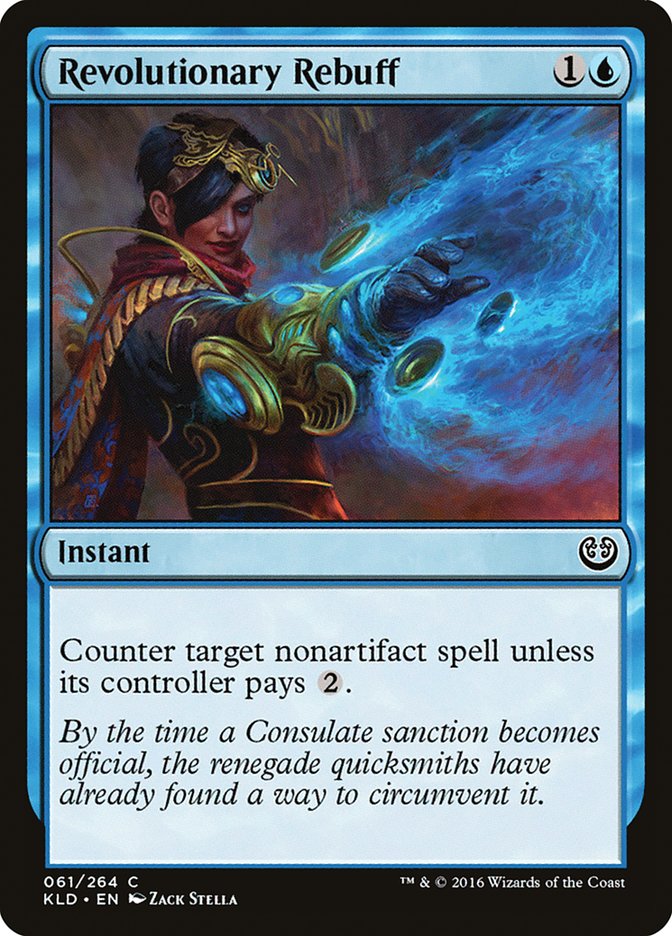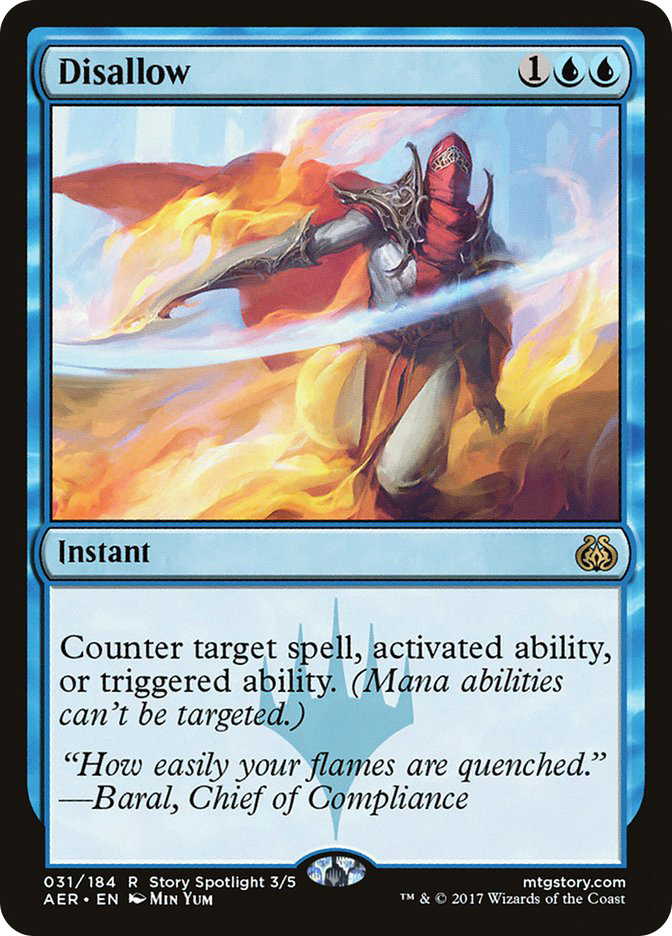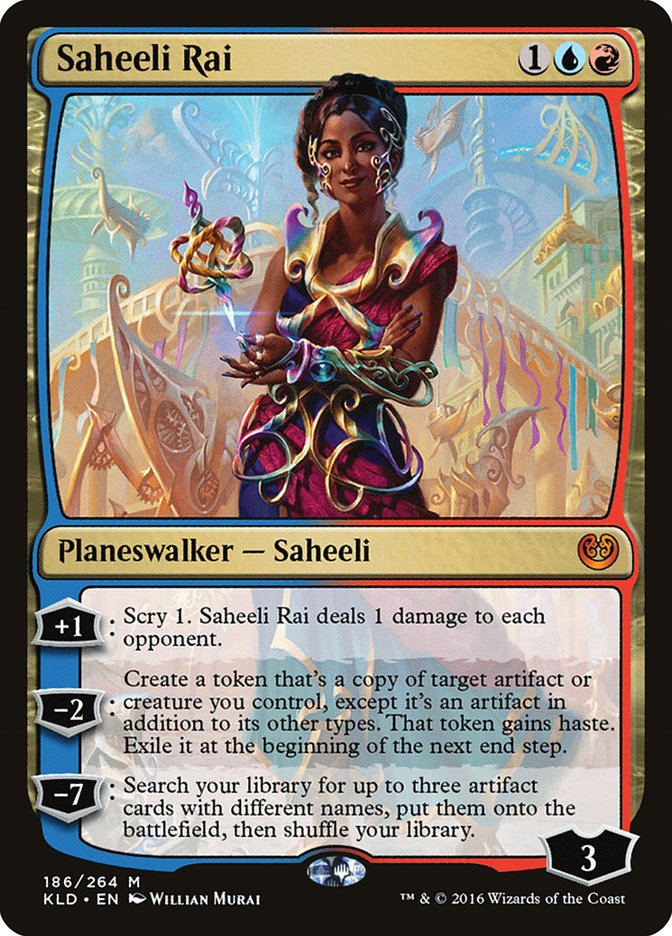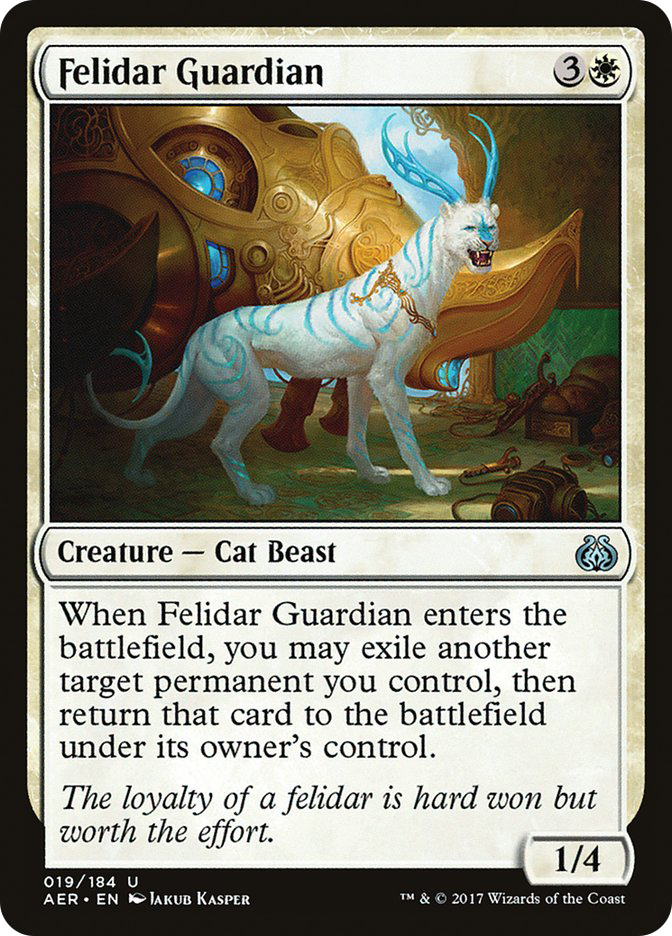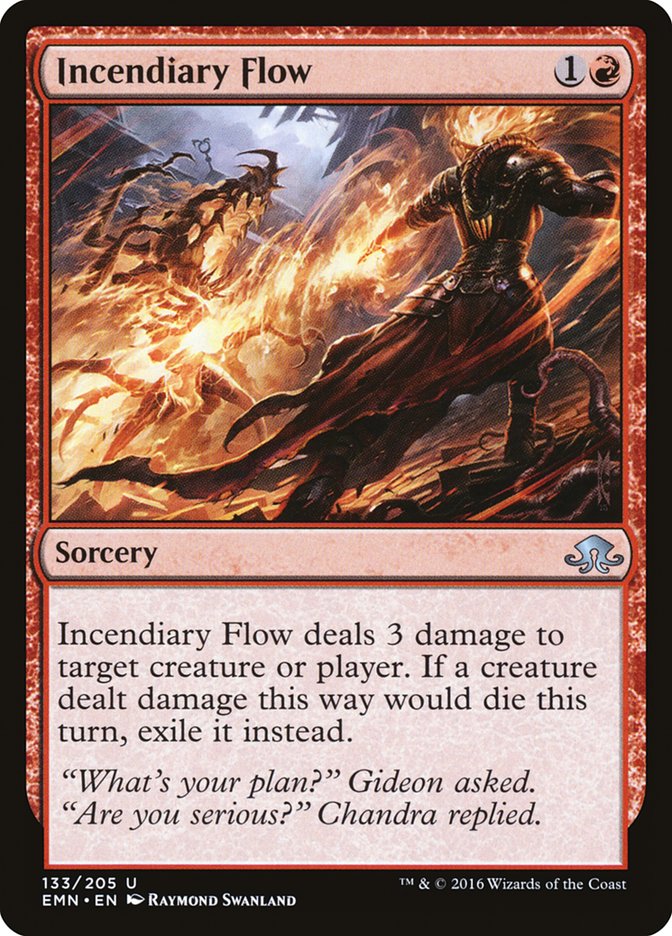It’s that time again, y’all! No, no, Christmas has come and gone. The holidays are over and it’s time to get back to work. With the release of Aether Revolt tomorrow, we’re moving into a whole new Standard world. Three cards were banned, and a new set has emerged with some very powerful cards and interactions. What’s not to like?
Luckily, for me, none of the cards I’m known for playing got the banhammer. Sure, I’ve cast my fair share of Smuggler’s Copter, Reflector Mage, and Emrakul, the Promised End in both tournaments and in the VS Series, but I never really liked casting them. Emrakul, the Promised End felt a lot like cheating. Smuggler’s Copter invalidated an entire card type in Standard (sorcery). Reflector Mage made a significant number of creatures in Standard unplayable.
Good riddance.
As you must know by now, I’m a fan of Izzet. I like casting cheap, synergistic creatures paired with removal spells and/or card draw spells. I like what I like. Sometimes that archetype is good in Standard, and sometimes I get the crap kicked out of me. But either way, it is what I like to do, so I’m going to do it a lot, and in the process also write about it a lot. Over the last few weeks, Izzet has been my primary focus, and even more so with the trifecta of banned cards. Last week, I talked about how the banning of Reflector Mage made Thing in the Ice a lot better. While I still believe that to be true, I’m leaning toward a slightly different version of Izzet for the SCG Tour Standard Open in Columbus this weekend.
So what are we talking about, exactly? In a nutshell: U/R Control. Glimmer of Genius makes it possible to play a draw-go game as a control deck. Not only do you gain a ton of value from being able to scry away mediocre cards, but you have the ability to put that two energy to good use. Mostly, it tends to turn Harnessed Lightning into Doom Blade. But, on occasion, it can pair well with something like Dynavolt Tower or even…
Whirler Virtuoso is a card that not a lot of people have seen out of a U/R Control strategy. In all honesty, it doesn’t seem like it really “fits.” But let me tell you, the defensive capability combined with a cheap body to put pressure on various planeswalkers is a big deal. Gideon, Ally of Zendikar is no longer an unbeatable threat once resolved. While you can’t churn out token after token with Whirler Virtuoso in this deck like a true energy-driven strategy, having a cheap threat that doesn’t mind dying to removal all that much is a refreshing change of pace for a blue control deck.
Some people are going to be stuck on Baral, Chief of Compliance (myself included, to an extent), but I honestly think that card will only be good in decks focused around Cathartic Reunion. Otherwise, I just don’t think you’ll get enough value out of it. The loot ability isn’t all that important, and the body is purely defensive. So with those things in mind, do you honestly think Baral, Chief of Compliance is a good enough card to play in your normal U/R Control deck? The verdict isn’t in just yet, but I have a hunch that it won’t make the cut. There are too many other powerful options at your disposal.
Whirler Virtuoso versus Thing in the Ice is going to be a pretty big debate for me. If I’m not going to splash the Felidar Guardian and Saheeli Rai combo, then I need a cheap threat that can pull me back into a game. Gaining small chunks of energy from Dynavolt Tower, Glimmer of Genius, and Harnessed Lightning will hopefully add up to enough to put Whirler Virtuoso in the lead. Plus, Fatal Push is a card that people want to start playing. Those two factors might just make Whirler Virtuoso the easy pick.
I honestly don’t know which one I prefer. What I do know is that Shock helps to kill planeswalkers in combination with Whirler Virtuoso. But I also know that the second and third copy of Galvanic Bombardment are pretty absurd. The real question is this: do you want four or more one-mana removal spells in your deck? If the answer is yes, I think you want to start with four Galvanic Bombardment. As the game goes long, a second or third Galvanic Bombardment will be able to take care of a larger creature, where Shock doesn’t really do a whole hell of a lot.
The appeal of Shock, when it was announced for Aether Revolt, was that it can break up the Saheeli Rai and Felidar Guardian combo. But at what cost? For me, the big swing is just the ability to clean up planeswalkers. By itself, it doesn’t do a whole lot, but it does combine well with some of your utility creatures to get the job done. Plus, if you’re going to play a version featuring Thermo-Alchemist, Shock should be a no-brainer. You want most, if not all, of your removal to be able to go to the skull. That way, when the game reaches a breaking point, you can start slinging all of your spells at your opponent in a blaze of glory. Galvanic Bombardment is not very good at accomplishing this goal.
Both have their strengths and weaknesses. I think how you build your U/R deck determines which of these two cards you should play.
I think Dynavolt Tower could be a minor player in just about any U/R deck, but it is an engine card that only requires you to play instants and sorceries to keep it moving. On the one hand, I love the card in Cathartic Reunion versions, but those decks are much different than the one I’m wanting to build today. Instead, I’ll just leave it at this:
I want to play one or two copies between maindeck and sideboard. This creates a healthy middle ground, both for fueling my Whirler Virtuoso as well as giving me a way to constantly interact with my opponent while drawing cards. Too many in this style of deck can lead to clunky draws that leave you dying to a swarm of small creatures or drawing too many against a deck without creatures. While it can act as a win condition, I don’t really view it as that type of a card. After all, it is no Pyromancer’s Goggles.
I’m not sure how many cheap counterspells I want to play. Baral, Chief of Compliance does make playing more copies of these a little more appealing. However, it doesn’t exactly put enough pressure on your opponent to force them to play into your Revolutionary Rebuff. While Revolutionary Rebuff can help contain creatures in the early turns, it becomes a dead card in a hurry. I’m not a huge fan of the card in general, but I wouldn’t be opposed to playing a few copies just to bridge the gap.
Negate, on the other hand, is a card I want to play quite a few of. As I’ve already discussed, Gideon, Ally of Zendikar can be a real pain in the neck. Having a few ways to keep it in check is important, and especially so when those answers only cost two mana. Revolutionary Rebuff can help in this regard, but the downside of becoming a dead card too quickly is a big deal. Plus, it can’t interact with an artifact-based strategy all that well.
These two cards are similar in a lot of ways. Both cost three mana and can counter a spell. Both are rather mopey but necessary in a control strategy. The strength of Void Shatter lies in whether or not the format is full of recurring elements. If there are a few decks playing stuff like Grapple from the Past, then Void Shatter could make all the difference. But right now is not that time.
While Disallow does virtually the same thing as Void Shatter, the one key difference is that there are some situations where you have to tap out. When you tap out, that can leave you vulnerable to all sorts of random activated or triggered abilities. I’m thinking Aetherworks Marvel. I’m thinking Aetherfulx Resevoir. I’m even thinking Evolving Wilds.
Man, that’s really going to make someone angry.
At times, Disallow will do just what you want it to do: counter some annoying spell. But then, in the heat of battle, it will save you from something you probably weren’t even thinking about. I’m talking Westvale Abbey, Key to the City, Haunted Dead. There are so many small spots in Standard where one “Stifle” will ruin your opponent’s best-laid plans. And you probably didn’t even see it coming.
At least, that’s the way I always felt when I was playing Stifle.
This isn’t Legacy. Disallow isn’t going to blow your opponent out too often. But the times it does will far outweigh the exile effect of Void Shatter, or even the awaken effect of Scatter to the Winds. You know how good Summary Dismissal was at stopping planeswalker ultimates? Well, now you have that on a card that is more efficient and easier to play in the maindeck.
Ah, yes. The Elephant in the room. This is the combo that everyone’s talking about. The rebirth of Splinter Twin, as it were. Well, it is and it isn’t. On the one hand, both halves of the original Splinter Twin combo rarely did much outside of tapping down an opponent’s land or creature. But the fact that Deceiver Exarch could be cast at instant speed was huge. You could sit back on Mana Leak or another counterspell, waiting for your opponent to do something. If they didn’t commit to the battlefield, tapping out, you were fine just waiting for a better turn. If they did tap out, then you could usually kill them on the spot thanks to the filtering of Ponder, Preordain, and even Shrine of Piercing Vision.
On the other hand, both Saheeli Rai and Felidar Guardian have value in places outside of their combination together. Saheeli Rai is surprisingly hard to kill in the early turns of the game. That means that you can usually cast it on the third turn, tick up to scry and dig for your combo, and eventually find a Felidar Guardian to reset the loyalty and kill your opponent. The chip damage from Saheeli Rai can also be relevant if you tilt your deck in a slightly more aggressive direction.
Felidar Guardian is in the same boat. Putting the combo in a deck that has a lot of enters-the-battlefield abilities means every Felidar Guardian is going to be a solid defender that also draws you a card, gains you some life, or creates more potential protection. While it is a bit slow, there are some very cool things you can do with Felidar Guardian to make it worthwhile, even without the combo. With a Panharmonicon on the battlefield, two copies of Felidar Guardian can make an arbitrarily large number of blink effects, allowing you to draw your deck, gain arbitrarily large mana, and cast just about anything your heart desires.
Plus, it’s a Cat.
Is the combo powerful? Sure. But it is a known quantity, and people know how to beat it. Even Shock can stop it. So now I gotta ask myself, do I want to “splash” the combo into a U/R Control shell? Some people seem to think so, but I’ve got another combo you might want to take a look at:
I haven’t had too much trouble winning games with the all-powerful Torrential Gearhulk combo. Fatcaster Mage, if you will. The body is large, the ability is in charge, and I say that no other combos are even remotely necessary. Torrential Gearhulk in combination with just about any instant, even the lowly Anticipate, should be enough to pull you back into the game. You’re able to play defense well, swallowing a creature upon arrival while killing another with Flashback on a removal spell. You’re able to generate card advantage by rebuying a Glimmer of Genius. You can stop even the most busted of effects or spells by reusing Disallow.
Cards like Torrential Gearhulk are only as good as the spells that surround it in the format. The current Standard offers up quite a juicy chunk of instants, making Torrential Gearhulk a perfect finisher for this style of deck.
Now, with all of that out of the way, let’s get to what you really came here for: the decklist.
Creatures (7)
Planeswalkers (1)
Lands (26)
Spells (26)

There is a very good chance I’ll be playing this deck at #SCGCOL. I honestly think the strategy is very good, and it seems right up my alley. My only concern is that Whirler Virtuoso might be much worse than I’m making it out to be, but I’m confident enough that it is better than the other options. Of course, the final option could be to play Torrential Gearhulk as the only creature.
I’m also concerned that this deck might be a little too inconsistent. If a creature sneaks under a counterspell and you don’t draw one of your ten pieces of removal, there’s a decent chance you just die. Hopefully Whirler Virtuoso alleviates some of that pressure. It does a great job at handling early creature rushes, even without much help.
Aside from the early creature rushes, I’m also afraid to play a control deck during the first week of a format. If only because I don’t know exactly what I’m going to be up against, but I could just be guessing wrong with a lot of my predictions. What if Void Shatter is better than Disallow? What if Incendiary Flow is necessary to beat Scrapheap Scrounger? What if my deck is just bad? Well, that last one goes for everyone. With so much changing in the new Standard format, I don’t know if any of us are really going to be “ready.”
I am a fan of trial by fire, to be sure. And boy do I like proving people wrong (I’m looking at you, Brad Nelson, always being a jerk and saying my U/R deck is bad). But more than I like proving people wrong, I just like winning. And if this deck doesn’t give me the best chance to do that, then I’m not afraid to jump ship. I love me some U/R, but I won’t hesitate to change sides if one of the Roanoke gang comes up with something truly busted. With Tom Ross, BBD, Michael Majors, and Brad Nelson (and Ross Merriam, I guess), the laws of probability dictate we’ll likely have a busted aggro deck, a solid midrange deck, and some wacky brews that probably need another week or two to perfect.
I’ll need to play a bit more of the new Standard format to really “get” everything. It is tough having to relearn how to cast a sorcery now that Smuggler’s Copter is gone. So much has changed, but that change feels almost impossible to put into words. We’ve had to deal with Reflector Mage and Emrakul, the Promised End for so long that we don’t even realize that we’ve had these deckbuilding parameters stuck in the back of our mind this entire time. Only because Smuggler’s Copter was legal in the format for just a few months did we realize how much it warped our removal packages, how much it shaped the archetypes we played, and how much it getting banned will hurt the decks that were relying on it.
The future is looking brighter today than it did just a few weeks ago. And because of that, I am happy. Now, if they could just reprint Lightning Bolt…


